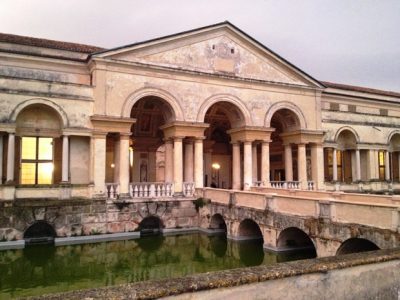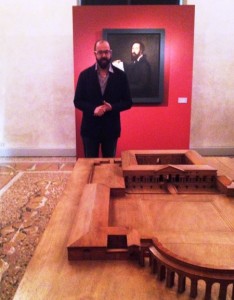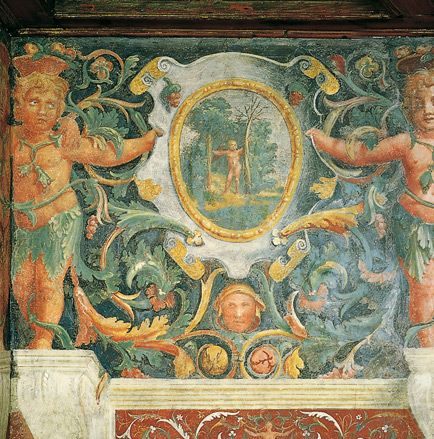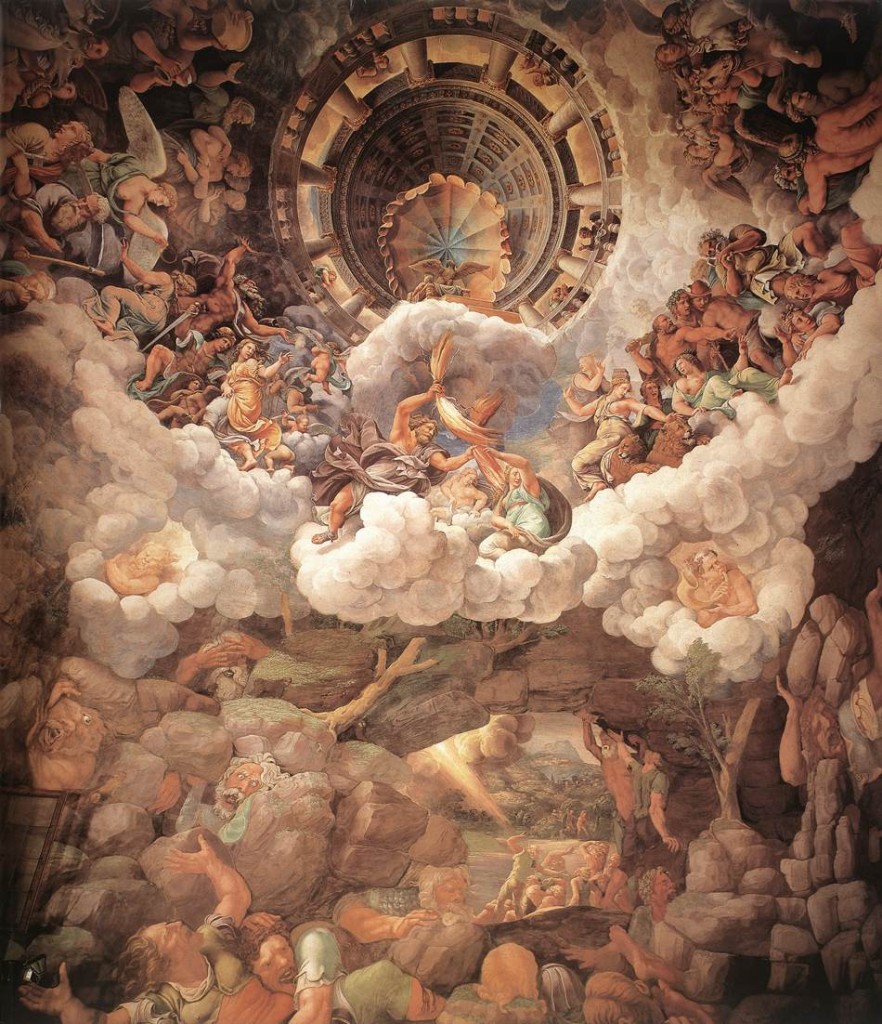After concluding our meetings and seminars at TBDI in Rimini, our group of international bloggers was quickly whisked off in a private bus for our post-conference tour in the Verona/Garda area of northern Italy. The weather was turning nasty, but it was comfortable inside our coach, snacks were provided, and someone else was driving. So I sat back and relaxed for a couple of hours as we made our way towards our first stop just outside of Mantua.
 Thankfully, the rain ceased and the sun fought to peak through the clouds just as we pulled up to Palazzo Te. From the vantage point of the wet parking lot, it wasn’t overly impressive—but then again, your criterion for what’s impressive gets grotesquely distorted the more you travel in Italy. Lethargic and a bit weary from my travels, I didn’t really anticipate the remarkable works of art that we were about to encounter once inside. We were in for quite a surprise, and we had the perfect guide to lead us through this unexpected discovery.
Thankfully, the rain ceased and the sun fought to peak through the clouds just as we pulled up to Palazzo Te. From the vantage point of the wet parking lot, it wasn’t overly impressive—but then again, your criterion for what’s impressive gets grotesquely distorted the more you travel in Italy. Lethargic and a bit weary from my travels, I didn’t really anticipate the remarkable works of art that we were about to encounter once inside. We were in for quite a surprise, and we had the perfect guide to lead us through this unexpected discovery.
We all knew Lorenzo quite well already, as he had been one of the group leaders during our stay in Rimini for the big TTG Incontri trade show. He was the facilitator between us—the writers/bloggers—and the high-profile travel industry brands that were attending the conference. But at Palazzo Te he was really in his element, as he introduced us to some of his “friends,” Federico Gonzaga II, a.k.a. the Duke of Mantua; and the Renaissance master Giulio Romano who designed and decorated the sprawling palazzo on the swampy grounds of a former horse stable.
 In the first room, we meet the creator of this fantasy of art and architecture, the aforementioned Giulio Romano, smartly presented in a portrait by another master, the great Titian. But it’s Giulio who is the only Renaissance master mentioned by William Shakespeare. In Act V, Scene II of The Winter’s Tale, Queen Hermione’s statue is by “that rare Italian master, Julio Romano.” Never mind that Giulio was never really a sculptor, he was still Raphael’s most accomplished pupil.
In the first room, we meet the creator of this fantasy of art and architecture, the aforementioned Giulio Romano, smartly presented in a portrait by another master, the great Titian. But it’s Giulio who is the only Renaissance master mentioned by William Shakespeare. In Act V, Scene II of The Winter’s Tale, Queen Hermione’s statue is by “that rare Italian master, Julio Romano.” Never mind that Giulio was never really a sculptor, he was still Raphael’s most accomplished pupil.
And Raphael would have been proud of this protégé. Giulio built and decorated this palace for his patron between the years 1525 and 1535. The style is considered Italian mannerist, which was sort of an ill-defined transition between the renaissance and baroque. Against the trend of the day, this palazzo contains almost no Christian imagery, save one scene from David and Goliath in a loggia overlooking the gardens. For the most part, we see scenes from Greek mythology and astrology, while cryptic symbolism and erotic images abound throughout the stylishly festooned rooms.
Also notable is the recurring image of Mount Olympus, a symbol representing the Duke’s loyalty to the Emperor, Charles V, instead of the Pope. The Dukedom of Mantua had traditionally been an ally of the Emperor, and Federico received the imperial investiture on April 7, 1521. And so he did not even attempt to stop the Imperial troops passing through his territory in 1527, indirectly contributing the subsequent Sack of Rome.
The Greatest Womanizer of the Renaissance
In case you’re wondering, Verdi’s story about the Duke of Mantua, recounted in his famous opera, Rigoletto, is as fictitious as Shakespeare’s Juliette. But perhaps we can say that the aria Questa o Quella captures the spirit of the real-life duke and his infamous womanizing (“This girl or that girl are just the same to me…”). Indeed, Signor Gonzaga did not commission this palatial estate for his beloved wife, who gave birth to his seven children. Rather, it was a temple erected (pun intended) to his carnal desires, in the form of a mistress: Isabella Boschetti.
The careful observer might also note an image of cupid standing among a small forest in a couple of the rooms (I am not a careful observer, so thankfully Lorenzo pointed this out to us). In Italian, the word “bosco” means forest, or woods. Playing with surname of his lover, the term “Boschetti,” could be taken to mean “little forests.” So then the final symbolism is that of Federico’s love (represented by cupid), residing in Isabella—the little forest. Kind of sweet, no? Well, yes, but I doubt that his wife shared the sentiment.

We also see the figure of a salamander throughout, in one room accompanied by the Latin phrase, “QUOD HUIC DEEST ME TORQUET,” meaning “What this [animal] has not, it is the reason for my pain,” referring to the cold blood of the Salamander, since Federico Gonzaga had very hot blood indeed!
Alas. Having suffered long from syphilis (no big surprise), The Duke of Mantua died in 1540 at his villa at Marmirolo at just 40 years of age. As the saying goes, if you’ll allow me, “You live by the sword, you die by sword.” Metaphorically speaking, in this case.
The bigger they are, the harder they fall
As I already mentioned, Palazzo Te was constructed 1525-1535. But the remarkable thing is that it only took 18 months to build the shell—the remainder of the time was spent adorning this sumptuous palace. For ten years, a team of plasterers, carvers, and fresco painters labored, until nearly every surface of every salon and loggia was covered with intricate works of art. (The blank spaces that you see today are where tapestries once hung.) There are scenes from Olympian banquets in the Sala di Psiche, and whimsical horses in the Sala dei Cavalli—perhaps an homage to the grounds’ former use as a stable. However, the masterpiece of their work is certainly the Sala dei Giganti—the Room of the Giants.
Lorenzo told us that this room was built for no other reason than to awe and inspire Federico’s guests. Which is certainly does. You are standing below with the defeated Giants as the gods of Olympus above you unleash their fury over the attempted coup d’état. Lightning bolts are flashing, the stone walls are crumbling, and the Giants scream out in fear. (Or maybe that was me.)

This illusion created by Giulio in this space is considered by many to be Mannerism’s greatest fresco, and it’s not hard to see why. You truly feel like you’re part of the scene; a trick of both perspective and emotion. I took a few photos and fled the room before being buried among the rubble with the giants.
The Cast of Characters
Our fearless leader, Lorenzo, runs a tour company called Visit Mantova, and I highly suggest that you look him up when visiting this part of Italy. He brings the art and the history to life with his great knowledge and even greater passion.
And I would like to mention the other friends that I made during this trip, which represents a traveling global village of devoted Italy lovers. I hope that our paths will cross again someday in future travels. In no particular order, I present to you some of the “Giants” of international bloggers…
From Central Florida, Jeff of Eurotravelogue.
From Amsterdam, Saskia of CiaoTutti
From Tuscany via Brazil, Deyse of Passeios na Toscana
From Hawaii, Noel of Travel Photo Discovery
From Berlin via Texas, Adam of Travels of Adam
From Rome via Australia, Maria of Heart Rome
From Sweden via Finland, Katja of Skimbaco Lifestyle
From Piemonte, Silvia of Nuovi Turismi
From Le Marche, Eleonora of Italian Storytellers

So interesting, thanks much,Rick.
Glad you enjoyed it, Sabine!
Well, you did it again! I have another new Iitalian newsletter to read: Italian Storytellers. I already read Heart Rome. Checked out most of the others, but Storytellers fit best especially since the English language is my one and only.
Of course I would now like to visit Mantua, but I fear unless my measly $2 a week wins the lottery, it won’t happen during next trip.
A presto,
PS Of course as usual I enjoyed your pun and comments!
Thanks Joan! And I’m pulling for you to win the lottery!